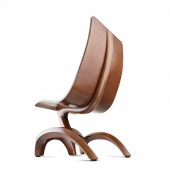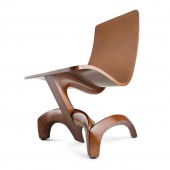
| THE AWARD |
| CATEGORIES |
| REGISTRATION |
| SUBMIT YOUR WORK |
| ENTRY INSTRUCTIONS |
| TERMS & CONDITIONS |
| PUBLICATIONS |
| DATES & FEES |
| METHODOLOGY |
| CONTACT |
| WINNERS |
| PRESS ROOM |
| GET INVOLVED |
| DESIGN PRIZE |
| DESIGN STORE |
| THE AWARD | JURY | CATEGORIES | REGISTRATION | PRESS | WINNERS | PUBLICATIONS | ENTRY INSTRUCTIONS |
Rabelo Lounge Chair by Paulo Jorge Faias Pereira |
Home > Winners > Design #59859 >Interview |
 |
|
FS: What is the main principle, idea and inspiration behind your design?
PP: I was exploring a form that I bring from my college days, the organic structure, is completely different from other existing chair in the market, I want to make and have completely different parts the ones that exist, I like movement I do not like static things, this seat has a similar form to the sail of a Portuguese ship that runs along the river Douro and was used to carries the port wine.
FS: What has been your main focus in designing this work? Especially what did you want to achieve?
PP: What I wanted to achieve it's done, is a robust chair but at the same time it is a sculpture that I did whit my own hands hand and with the help of specialized artisans
FS: What are your future plans for this award winning design?
PP: Go to exhibitions to show my work that in fact is different, is from Portugal has name and spirit of this people, of course also will be marketed.
FS: How long did it take you to design this particular concept?
PP: This chair had a lot of drawing small and real scale drawings then I make computer drawings and a scale mockup in wood to understand how it would stay, other models came to follow but in real scale everything done as a sculpture, this took me about 4 months to create the template.
FS: Why did you design this particular concept? Was this design commissioned or did you decide to pursuit an inspiration?
PP: This model is my inspiration, almost like all I do, I go over the days making drawings, taking advantage of ideas, environments and places that inspire me and affect me at the moment of inspiration drawing.
FS: Is your design being produced or used by another company, or do you plan to sell or lease the production rights or do you intent to produce your work yourself?
PP: I intend produce myself, are models made by me and people I met in Portugal young people who bring the experience of the parents, are very good and we are in this together is interesting this dynamics design and craftsmanship very wise and collaborator.
FS: What made you design this particular type of work?
PP: It's a necessity that I have to do always something, I can not stopped, is my work, briefly someone is going to ask me what led you to do this other, and I'll tell you that the same motivation with which I did the Rabelo.
FS: Where there any other designs and/or designers that helped the influence the design of your work?
PP: Leonardo da Vince e Gaudi, and there is a designer that I really like his style the Ross Lovegrove, has a chair with a curved central column.
FS: Who is the target customer for his design?
PP: Anyone who likes and wants to have it, just order.
FS: What sets this design apart from other similar or resembling concepts?
PP: It was made to be unique, did not cling to anything existing, this kind of leg, foot and seat is rare and you do not see around there chairs like that.
FS: How did you come up with the name for this design? What does it mean?
PP: Rabelo is the name of a boat that is used to transport Port wine on the Douro River, the seat is similar to the sail of the boat and the feet the water that runs to the both sides.
FS: Which design tools did you use when you were working on this project?
PP: A lot of drawing in blocks, then computer program Rhinocerus, make wooden mockups until having the final to take to the factory.
FS: What is the most unique aspect of your design?
PP: It is to have movement, rhythm, and always to explore the organic.
FS: Who did you collaborate with for this design? Did you work with people with technical / specialized skills?
PP: I did this work alone only after I went to look for collaboration to perform the final model.
FS: What is the role of technology in this particular design?
PP: In this design isn't there any technology, it is totally hand made.
FS: Is your design influenced by data or analytical research in any way? What kind of research did you conduct for making this design?
PP: Is not influenced by any of this.
FS: What are some of the challenges you faced during the design/realization of your concept?
PP: Many factories and many people did not believe that I could do it, but I I did it, only needed to find the right partner.
FS: How did you decide to submit your design to an international design competition?
PP: I saw design contests I was curious and I looked for this kind of contests was when I saw this and I signed up.
FS: What did you learn or how did you improve yourself during the designing of this work?
PP: That I will continue to do many more things, I believe in myself, and in what I can do and I believe that those are coming next will be different and good as well.
FS: Any other things you would like to cover that have not been covered in these questions?
PP: Nothing more, thank you.
FS: Thank you for providing us with this opportunity to interview you.
A' Design Award and Competitions grants rights to press members and bloggers to use parts of this interview. This interview is provided as it is; DesignPRWire and A' Design Award and Competitions cannot be held responsible for the answers given by participating designers.
| SOCIAL |
| + Add to Likes / Favorites | Send to My Email | Comment | View Press-Release |




